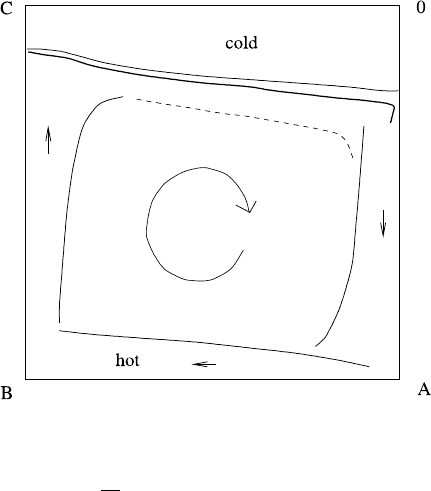Fowler A. Mathematical Geoscience
Подождите немного. Документ загружается.


500 8 Mantle Convection
In the delamination layer, a balance of advection with conduction implies
ψ ∼1/δ, and because buoyancy (
θdψ)is advected round the corner, we have
θ
p
δ
p
=
1
δ
. (8.181)
Finally, we must balance shear stress with buoyancy in the delamination layer (by
analogy with the boundary layer beneath a rigid lid). Thus p
x
∼ τ
3z
, p
z
∼ Raεθ,
and since ∂/∂x ∼1/ε (since ν =δ/ε) and ∂/∂z ∼1/δ, we have in the delamination
layer
τ
3
∼δ
2
Ra,p∼εδRa, (8.182)
and together with ψ ∼1/δ, ∂/∂z ∼ 1/δ
2
, the definition τ
3
≈ ηψ
zz
( τ
1
) implies
τ
3
∼ τ ∼ η/δ
3
∼ Λ/τ
n−1
δ
3
, hence τ
3
∼ τ ∼ (Λ/δ
3
)
1/n
, and combining this with
(8.182) and (8.179), we find
δ
2
Ra =
1
δ
3
δ
2(n−1)
p
1/n
. (8.183)
From (8.178), (8.179), (8.180), (8.181) and (8.183), we finally find
δ =
ε
n−1
n+1
Ra
1/5
,Λ=Ra
3(n−1)
5
ε
(2n+3)(n−1)
5(n+1)
. (8.184)
The second of these defines η
0
, and ensures that the sub-lithospheric viscosity is
O(η
0
).From(8.175), we have
Λ =
(d
2
/κ)
n−1
2A
.
1
η
n
0
exp(1/ε). (8.185)
Combining this with (8.184), we find
η
0
=
(d
2
/κ)
n−1
2A
exp
E
∗
RT
a
5
E
∗
RT
a
(2n+3)(n−1)
(n+1)
κ
αρ
a
gT
a
d
3
3(n−1)
1
2n+3
.
(8.186)
As discussed above, we have T
a
≈T
b
, and more precisely, we can define
T
a
=
T
b
1 +
εδ
p
δ
φ
b
, (8.187)
where the unknown O(1) constant φ
b
is chosen in an analysis of the basal boundary
layer (cf. (8.200) below). In effect we can take T
a
as known. Taking all the values for
the constants which we have used earlier, we find that the expected value of η
0
for
the Earth is 1.4 ×10
20
Pa s. Extraordinarily, this is exactly the sort of value which
is thought to be appropriate in the Earth’s asthenosphere. The theory smells right.

8.5 Variable Viscosity 501
Delamination Layer We would now progress through the separate regions: core,
basal boundary layer, plumes, etc. These are much the same as for the constant
viscosity case, but the delamination layer (and the slab above) is different, and we
begin with it.
In the delamination layer, we rescale the variables as follows, based on the dis-
cussion above:
z =1 −νs −δζ, T =1 +εθ, τ =δ
2
RaT
∗
,η=ε
n−1
n+1
N,
ψ =
Ψ
δ
,p=εδRaP, τ
3
=δ
2
RaT
3
,τ
1
=
δ
3
Ra
ε
T
1
;
(8.188)
thus
∂
∂x
→
∂
∂x
−
s
ε
∂
∂ζ
,
∂
∂z
→−
1
δ
∂
∂ζ
, (8.189)
and at leading order we find (assuming δ ε)
−s
∂P
∂ζ
=−
∂T
3
∂ζ
,
−
∂P
∂ζ
=θ,
T
1
=−2N
∂
2
Ψ
∂ζ
2
,
T
3
=−N
∂
2
Ψ
∂ζ
2
,
∂Ψ
∂ζ
∂θ
∂x
−
∂Ψ
∂x
∂θ
∂ζ
=
∂
2
θ
∂ζ
2
,
T
∗
=|T
3
|,
N =
1
T
∗n−1
e
−θ
.
(8.190)
We write T
3
=−S; then (8.190) can be shrunk to the three coupled equations
∂S
∂ζ
=s
θ,
∂
2
Ψ
∂ζ
2
=|S|
n−1
Se
θ
,
∂Ψ
∂ζ
∂θ
∂x
−
∂Ψ
∂x
∂θ
∂ζ
=
∂
2
θ
∂ζ
2
.
(8.191)
We anticipate suitable boundary conditions for these equations as follows. As
ζ →−∞, the viscosity increases exponentially as we enter the lid, and we an-
ticipate negligible flow and a conductive temperature gradient. Thus
Ψ →0,θ
ζ
→Γ (8.192)

502 8 Mantle Convection
as ζ →−∞. Below the lid lies the isothermal core, and hence we can suppose
S →S
∞
,θ→0asζ →+∞, (8.193)
where S
∞
must be chosen. Because p,τ
1
,τ
3
∼1/δ
2
p
in the core, and because (from
(8.180) and (8.181))
1
δ
4
p
=
Ra ε
δ
, (8.194)
we find, using the definition of δ in (8.184), that the delamination layer scaled vari-
ables P and T
3
take values
P ∼νε
1
n+1
,T
3
∼ε
1
n+1
(8.195)
in the core. Thus T
3
must reach O(ε
1
n+1
) 1 in the core, and an obvious choice for
S
∞
is thus S
∞
= 0. Despite its appeal, we shall find that this is incorrect, because
of a further buoyant layer below the delamination layer which arises from the up-
welling plume. Before considering the plume structure, we solve for the temperature
in the lid.
Stagnant Lid Temperature Anticipating that ψ 1 (fuller discussion follows
later), then ∇
2
T =0 in the lid. We rescale
z =1 −νZ, (8.196)
so that
T
ZZ
+ν
2
T
xx
=0, (8.197)
and at leading order
T =T
0
+(1 −T
0
)
Z
s
, (8.198)
where T
0
=T
s
/T
a
is the non-dimensional surface temperature. It follows from the
definition of (8.192) that
Γ =
∂T
∂Z
Z=s
=
1 −T
0
s
. (8.199)
Sub-lithospheric Flow In the plumes and the basal thermal boundary layer,
θ ∼ δ
p
/δ 1, so that viscosity is approximately constant, and the flow is directly
comparable to the isoviscous case. However, the upper boundary for the core flow
is now one of no slip, so that the flow is not symmetric, and the buoyancy in each
plume may be different.
Put
θ =
δ
p
δ
φ, (8.200)

8.5 Variable Viscosity 503
Fig. 8.4 The style of
stagnant lid convection for a
strongly variable viscosity
fluid
and write
ψ =
1
δ
p
Ψ (8.201)
in plumes and basal boundary layer. Suppose that
∞
0
φdΨ =C
l
, −C
r
, (8.202)
give the values of plume buoyancy in the left and right plumes (C
l
,C
r
> 0).
Note that if we choose T
a
such that θ ≡ 0 in the core, then the value of φ at the
base is undetermined, let us say φ = φ
b
at z = 0. (This just reflects the fact that
the internal core temperature T
a
is not exactly known.) Thus we have to determine
φ
b
,C
l
and C
r
.
The core flow problem for
ˆ
ψ =δ
2
p
ψ is the following:
∇
4
ˆ
ψ =0, (8.203)
with
ˆ
ψ =0,
ˆ
ψ
x
ˆ
ψ
xx
=C
l
on x =0,
ˆ
ψ =0,
ˆ
ψ
x
ˆ
ψ
xx
=−C
r
on x =a,
ˆ
ψ =0,
ˆ
ψ
zz
=0onz =0,
ˆ
ψ =0,
ˆ
ψ
z
=0onz =1.
(8.204)
Given the solution to this, then the anti-clockwise boundary velocity on the edges
OABC (see Fig. 8.4)isu =∂
ˆ
ψ/∂n, where n is the inward normal, and if we define

504 8 Mantle Convection
τ (no longer the stress!) by
τ =
s
0
uds, (8.205)
where s measures distance anti-clockwise along OABC from O, then φ satisfies
∂φ
∂τ
=
∂
2
φ
∂Ψ
2
in 0 <Ψ <∞, 0 <τ<τ
C
, (8.206)
where Ψ = δ
p
ψ is the boundary layer coordinate, and if τ = 0,τ
A
,τ
B
,τ
C
at the
points O,A,B,C, then suitable boundary conditions are
φ →0asΨ →∞,
φ
Ψ
=0onΨ =0, 0 <τ<τ
A
and τ
B
<τ <τ
C
,
φ =φ
b
on Ψ =0,τ
A
<τ <τ
B
.
(8.207)
Outer Thermal Layer At this point we must enquire what happens to the up-
welling plume after it impinges the lid at x = 0. We have already described the
delamination layer, in which ψ ∼ 1/δ, θ ∼ 1 and 1 − νs − z ∼ δ. In the plume,
however, ψ ∼1/δ
p
and θ ∼δ
p
/δ. The plume turns the corner and is carried across
in an outer thermal layer below the delamination layer. In this layer, we write (from
the delamination layer variable)
ζ =
δ
δ
p
1/2
η, (8.208)
which is appropriate if S
∞
=0in(8.193).
We then find that at leading order,
−s
∂P
∂η
=−
∂T
3
∂η
,
−
∂P
∂η
=φ,
T
3
=−N
∂
2
Ψ
∂η
2
,
T
1
=−2Ns
∂
2
Ψ
∂η
2
,
T
∗
=|T
3
|,
N =
1
T
∗n−1
,
Ψ
η
φ
x
−Ψ
x
φ
η
=0,
(8.209)
provided ε (δ
p
/δ)
1/2
, which we assume.

8.5 Variable Viscosity 505
It firstly follows that φ ≈ φ(Ψ), and the plume buoyancy structure is advected
across the top surface unchanged. Secondly, S =−T
3
and Ψ satisfy the equations
∂
2
Ψ
∂η
2
=|S|
n−1
S,
∂S
∂η
=s
φ(Ψ),
(8.210)
with matching conditions
Ψ =Ψ
η
=0,S=S
∞
on η =0,
S →0asη →∞.
(8.211)
The extra condition determines the value of S
∞
, which is then used to solve the
delamination layer equations (8.191).
Plume Circulation Returning now to the model for φ in the plumes, (8.206) and
(8.207), we see that if the upwelling plume value at x = 0, τ =τ
C
is φ
C
(Ψ ), then
∞
0
φ
C
(Ψ ) dΨ =−C
r
. (8.212)
The change in the buoyancy
∞
0
φdΨ across the top surface is (C
l
+C
r
), but this
is manifested in the delamination layer (where Ψ ∼δ
p
/δ 1). Therefore the initial
condition for the plume at x =a, τ =0, may be approximately represented as
φ|
τ =0
=φ
C
(Ψ ) −(C
r
+C
l
)δ
+
(Ψ ), (8.213)
where the half-range delta function δ
+
(Ψ ) is zero for Ψ>0, and
∞
0
δ
+
(Ψ ) dΨ =1.
In addition, we have the heat flux conditions
C
l
+C
r
=−
τ
B
τ
A
∂φ
∂Ψ
Ψ =0
dτ (8.214)
at the base, and similarly at the top
C
l
+C
r
=
a
0
Γdx=(1 −T
0
)
a
0
dx
s
. (8.215)
We can simplify the model as follows. Define
γ =
C
l
C
l
+C
r
, 2C =C
l
+C
r
. (8.216)
Given s,(8.215) defines C. The core stream function can be written as
ˆ
ψ =C
1/2
ψ
γ
, (8.217)

506 8 Mantle Convection
where ψ
γ
(γ is merely a labelling superscript, not an exponent) depends only on γ ,
the relevant plume conditions being
ψ
γ
ψ
γ
xx
=2γ on x =0,
ψ
γ
ψ
γ
xx
=2(1 −γ) on x =a.
(8.218)
Next we define σ by
φ =2Cσ −
2C
√
πτ
exp
−
Ψ
2
4τ
, (8.219)
so that σ satisfies
σ
τ
=σ
ΨΨ
in 0 <Ψ <∞, 0 <τ<τ
C
, (8.220)
with boundary conditions
σ →0asΨ →∞,
σ
Ψ
=0onΨ =0, 0 <τ<τ
A
,
σ =α +
1
√
πτ
on Ψ =0,τ
A
<τ <τ
B
,
σ
Ψ
=0onΨ =0,τ
B
<τ <τ
C
,
(8.221)
where
φ
b
=2αC, (8.222)
and we require, from (8.212)–(8.214),
σ |
τ =0
=σ |
τ =τ
C
−
1
√
πτ
C
exp
−
Ψ
2
4τ
C
, (8.223)
−
τ
B
τ
A
∂σ
∂Ψ
Ψ =0
dτ =1, (8.224)
∞
0
σ |
τ =0
dΨ =γ. (8.225)
Now since
ˆ
ψ =C
1/2
ψ
γ
, it follows that
τ =C
1/2
s
0
∂ψ
γ
∂n
ds, (8.226)
so we define
τ =C
1/2
ˆτ, Ψ =C
1/4
χ, σ =Σ(χ, ˆτ)/C
1/4
, (8.227)

8.5 Variable Viscosity 507
and τ
A
=C
1/2
ˆτ
A
,etc.Σ satisfies
Σ
ˆτ
=Σ
χχ
, (8.228)
with
Σ →0asχ →∞,
Σ
χ
=0onχ =0, 0 < ˆτ<ˆτ
A
,
Σ =ˆα +
1
√
π ˆτ
on χ =0, ˆτ
A
< ˆτ<ˆτ
B
,
Σ
χ
=0onχ =0, ˆτ
B
< ˆτ<ˆτ
C
,
(8.229)
where ˆα =αC
1/4
, and the constraints
Σ|
ˆτ =ˆτ
C
=Σ|
ˆτ =0
+
1
π ˆτ
C
exp
−
χ
2
4 ˆτ
C
, (8.230)
−
ˆτ
B
ˆτ
A
∂Σ
∂χ
χ=0
d ˆτ =1, (8.231)
∞
0
Σ|
τ =0
dχ =γ. (8.232)
The value of ˆα is chosen so that (8.231) is satisfied. Given an initial function
Σ
0
(χ) =Σ|
ˆτ =0
,wesolve(8.229) with (8.231) till ˆτ =ˆτ
c
, which determines Σ|
ˆτ =ˆτ
c
as a linear functional of Σ
0
.(8.230) is then a linear inhomogeneous integral equa-
tion, with (so we suppose) a unique solution, which depends on γ , since ˆτ
A
, ˆτ
B
and
ˆτ
C
depend on γ .(8.232) then provides an equation for γ . Note that the plume head
value of φ
C
(Ψ ) used in (8.210) is given by
φ
C
(Ψ ) =2C
3/4
Σ
0
Ψ/C
1/4
. (8.233)
It remains to determine s and thus C,via(8.215):
2C =(1 −T
0
)
a
0
dx
s
. (8.234)
This appears to require that s can be fully determined through the solution of
(8.191). We now consider whether this can be true.
Delamination Layer: Similarity Solution The delamination equations (8.191)
form a fifth order set of differential equations. One can argue that the boundary
conditions in (8.192) and (8.193) actually constitute six conditions, since the implied
conditions Ψ →0asζ →−∞and θ
ζ
→0asζ →∞are understood. If that is the
case, then we can expect that s
in (8.191) is a nonlinear eigenvalue for the model,
and thus (since also Γ depends on s), that the solution will implicitly determine a
differential equation of the form s
=Υ(s)for s.

508 8 Mantle Convection
If that is the case, then the question arises what is the appropriate boundary con-
dition for s? One possibility is that s(0) =0; another would be that s
(0) =0, which
would determine s(0) as the root (if it exists) of Υ = 0. Without detailed matching
of the delamination layer to the corner flow, it is difficult to be more precise.
Some insight into this question can be gained if we suppose that S
∞
= 0in
(8.193). This would follow if the function φ
C
(Ψ ) used in the solution of (8.210)
is identically zero. In this case, Eqs. (8.191) have a similarity solution, and this is
given by
ξ =Γ(x)ζ, θ =g(ξ), T
3
=
−s
Γ
h(ξ), Ψ =
s
Γ
3
s
Γ
n−1
f(ξ).
(8.235)
The functions f, g, h then satisfy the equations
h
=g,
f
=|h|
n−1
he
g
,
g
+B
n
fg
=0,
(8.236)
with
g(∞) =h(∞) =0,f(−∞) =0,g
(−∞) =1, (8.237)
providing s satisfies the equation
s
Γ
3
s
Γ
n−1
=B
n
Γ. (8.238)
Given Γ , this equation determines the location of the (unknown) lithosphere base.
To solve (8.236), we use a shooting method for the equation with B
n
=1:
H
=G,
F
=|H |
n−1
He
G
,
G
+FG
=0,
(8.239)
with
F =F
=0,G
=c, G =−cM, H =H
0
+
1
2
cM
2
at ξ =−M,
(8.240)
and M is chosen to be large (M = 20 is adequate). The values of H
0
and c are
adjusted via Newton iteration at ξ = M until G = H =0 there. Once a solution is
found, then f, g, h are determined by
g(ξ) =G(ξ/c), h(ξ ) =cH (ξ /c), f (ξ) =c
n+2
F(ξ/c), (8.241)

8.5 Variable Viscosity 509
Table 8.1 Va lu es o f B
n
nB
n
1 0.087
24.74 ×10
−3
31.39 ×10
−4
3.5 1.98 ×10
−5
42.53 ×10
−6
53.15 ×10
−8
and
B
n
=
1
c
n+3
. (8.242)
AsshowninTable8.1, B
n
is small and decreases rapidly as n increases.
Lithosphere Base We substitute (8.199)into(8.238), so that
s
n+2
s
n
=
B
n
(1 −T
0
)
n+3
s
(8.243)
(since Γ>0, and thus we can take s
> 0). In order to complete the solution for
s(x), we require two boundary conditions. It is not entirely obvious where these are
to come from. One reasonable choice would appear to be s
(0) =0, which ensures
that Ψ → 0asx → 0 (as would appear necessary, not only because of the vertical
boundary at x =0, but also because Ψ ∼δ
p
/δ 1 in the plume). If s =s
0
at x =0,
then the solution of (8.243)as
s
s
0
s
n+2
n
ds
s
n+2
n
−s
n+2
n
0
1
n+1
=bx, (8.244)
where
b =
n +1
n +2
B
n
(1 −T
0
)
n+3
1
n+1
. (8.245)
More likely, however, is that we should choose s(0) = 0, on the basis that the
similarity variable is ξ =
(1−T
0
)ζ
s
, and identification of x →0 with ζ →∞, as usual
in similarity solutions, requires this condition. In that case, the solution for s is
s =
(2n +3)bx
n +1
n+1
2n+3
, (8.246)
and the determination of the solution is complete.
